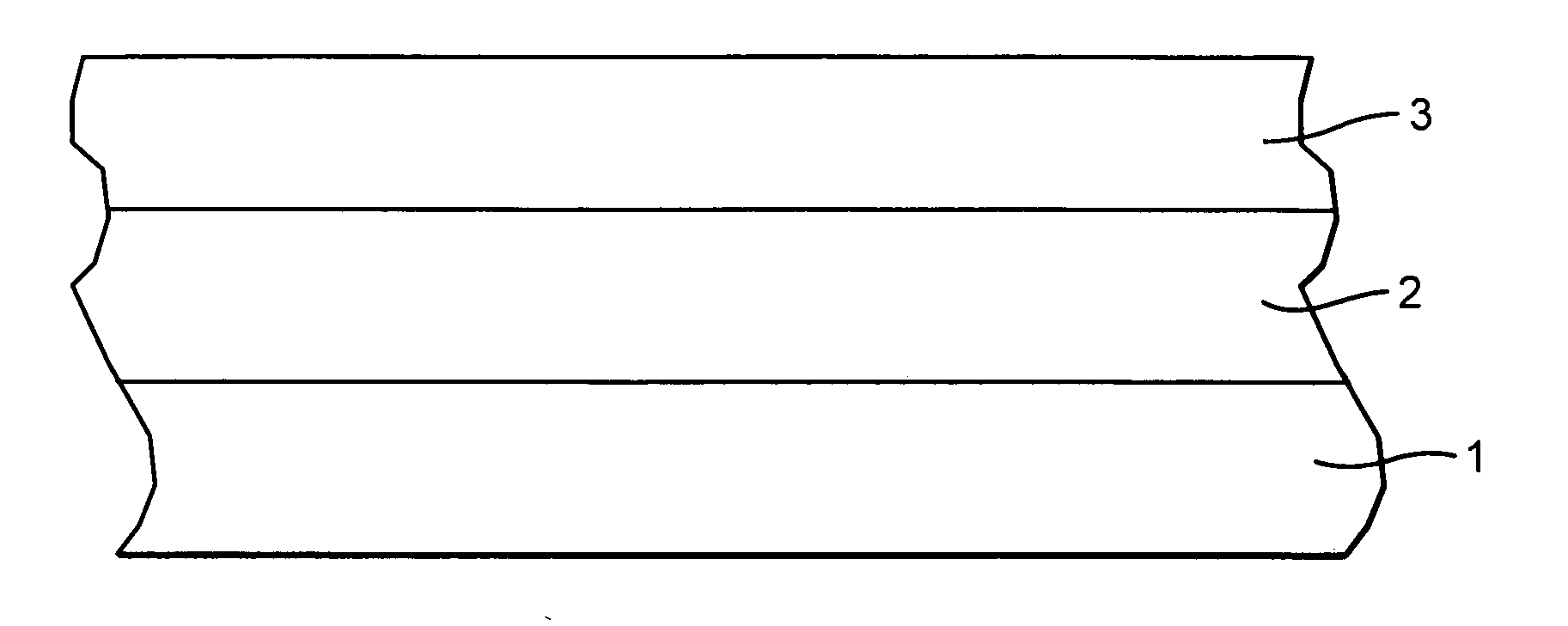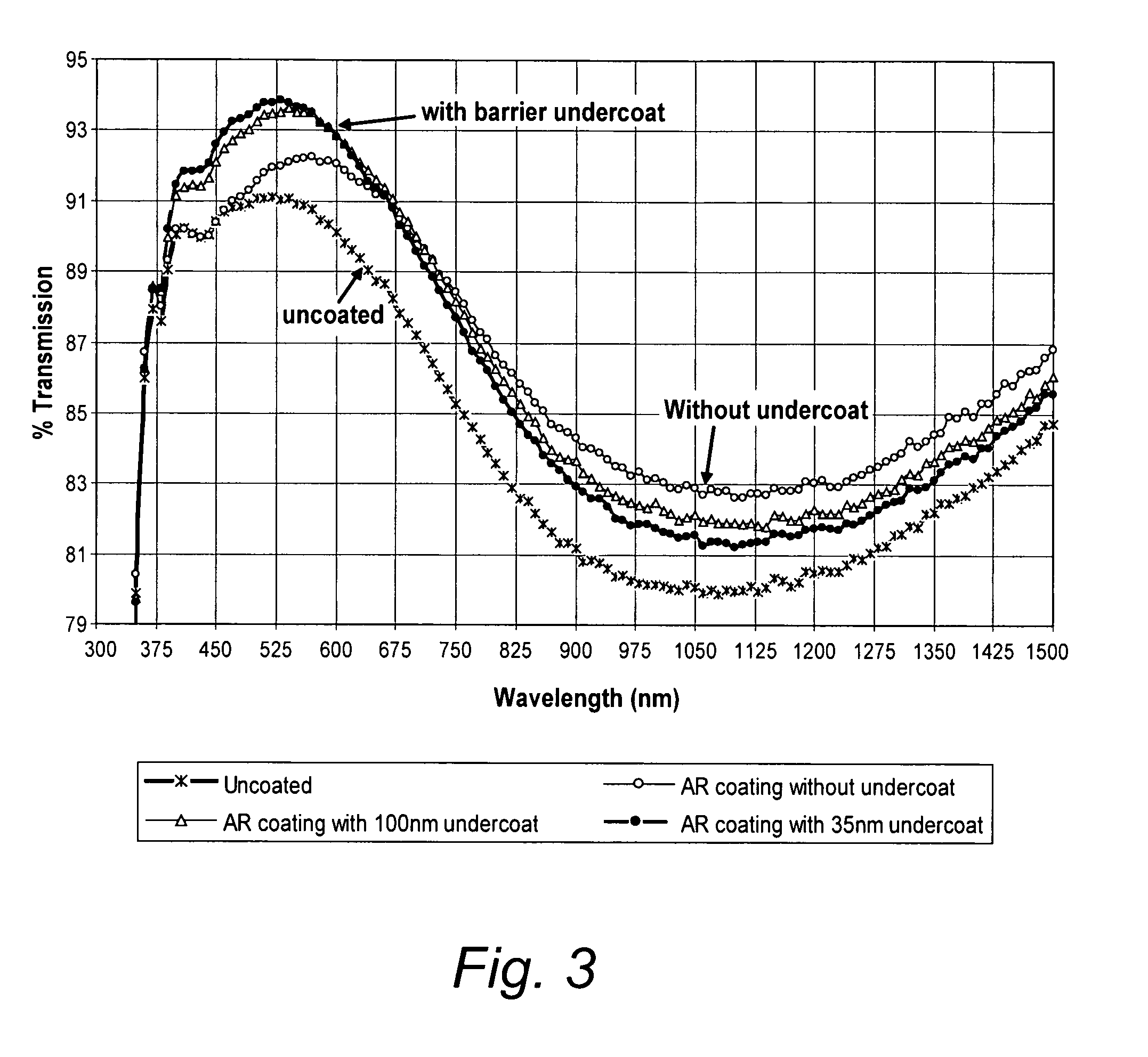Method of making an antireflective silica coating, resulting product, and photovoltaic device comprising same
a technology of anti-reflective silica and silica gel, which is applied in the direction of optical elements, instruments, transportation and packaging, etc., can solve the problems of affecting the efficiency of solar cells, affecting the performance of solar cells, so as to inhibit the corrosion of glass substrates
- Summary
- Abstract
- Description
- Claims
- Application Information
AI Technical Summary
Benefits of technology
Problems solved by technology
Method used
Image
Examples
example # 1
EXAMPLE #1
[0046]In this example, an AR coating of silica was produced using the sol-gel method. The silica solution for AR coating was prepared as follows. A polymeric component of silica was prepared by using 64% wt of n-propanol, 24% wt of glycydoxylpropyltrimethoxysilane (Glymo) (available from Aldrich), 7% wt of water and 5% wt of hydrochloric acid. These ingredients were used and mixed for 24 hrs. The coating solution was prepared by using 21% wt of polymeric solution, 7% wt colloidal silica in methyl ethyl ketone supplied by Nissan Chemicals Inc, and 72% wt n-propanol. This was stirred for 2 hrs to give silica sol. The final solution is referred to as silica sol for AR coating. The silica coating was fabricated using spin coating method with 1000 rpm for 18 secs. The coating was heat treated in furnace at 625° C. for three and a half minutes.
[0047]The environmental durability of the coating was done under following conditions. Ramp—Heat from room temperature (25° C.) to 85° C....
example # 2
EXAMPLE #2
[0048]In this example, an barrier undercoat of silica was produced using the sol-gel method. The sol-gel method was used to fabricate the silica barrier layer by using 64% wt of n-propanol, 24% wt of glycydoxylpropyltrimethoxysilane (Glymo), 7% wt of water and 5% wt of hydrochloric acid. The silica coating was fabricated using spin coating method with 1000 rpm for 18 secs. The coating was heated in oven at 220° C. for 2.5 minutes. The refractive index of the coating was 1.4. Once the coatings became cool down to room temperature, AR coating of silica was deposited which also made from sol-gel method (from example #1). The silica coating was fabricated using spin coating method with 1000 rpm for 18 secs. The coating was heat treated in furnace at 625° C. for three and a half minutes. The environmental durability of the coating was done as mentioned in example #1. The transmission measurements were done using PerkinElmer UV-VIS Lambda 950 before and after the environmental t...
example # 3
EXAMPLE #3
[0049]In this example, an barrier undercoat of silica was produced using the sputtering method. The silica barrier layer had a refractive index of 1.46. The thickness of this coating was 93 nm. The top coat on the barrier coating was made by using sol-gel method. The silica sol preparation, heat treatment and environment conditions are same as mentioned in the example #1. Table 2 shows the transmission of coatings before and after the humidity and freeze testing.
PUM
| Property | Measurement | Unit |
|---|---|---|
| temperature | aaaaa | aaaaa |
| refractive index | aaaaa | aaaaa |
| temperature | aaaaa | aaaaa |
Abstract
Description
Claims
Application Information
 Login to View More
Login to View More - R&D
- Intellectual Property
- Life Sciences
- Materials
- Tech Scout
- Unparalleled Data Quality
- Higher Quality Content
- 60% Fewer Hallucinations
Browse by: Latest US Patents, China's latest patents, Technical Efficacy Thesaurus, Application Domain, Technology Topic, Popular Technical Reports.
© 2025 PatSnap. All rights reserved.Legal|Privacy policy|Modern Slavery Act Transparency Statement|Sitemap|About US| Contact US: help@patsnap.com



